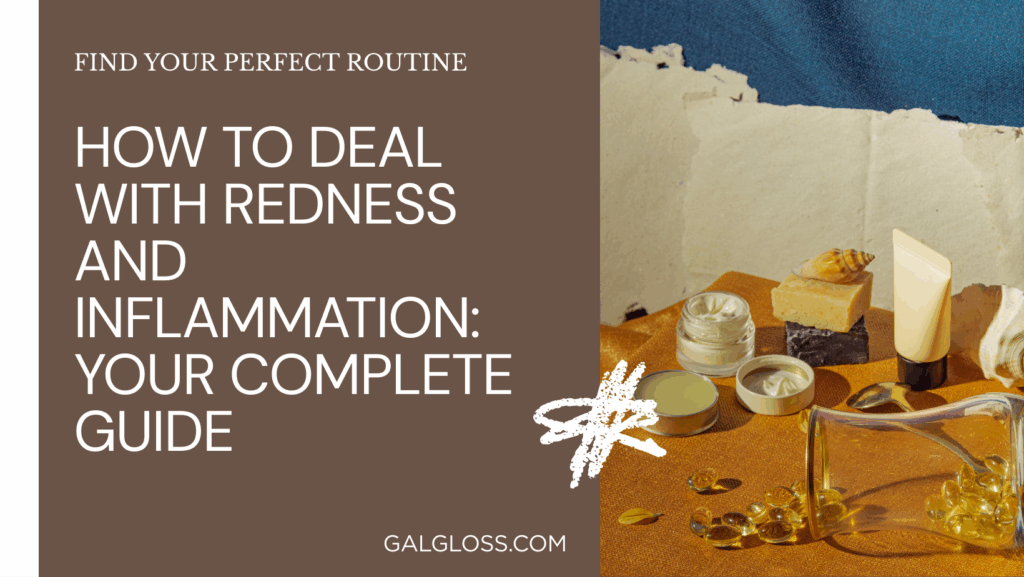Ever looked in the mirror and wondered why your face looks like a traffic light? You’re not alone. Redness and inflammation are super common skin issues that can make us feel less than fabulous. But don’t worry – I’ve got your back!
In this guide, we’ll dive deep into the world of angry, irritated skin. We’ll explore what causes that pesky redness, how to calm it down fast, and how to keep it at bay long-term. Whether you’re dealing with a temporary flare-up or a chronic condition, you’ll find practical tips to help you face the world with confidence.
Ready to say goodbye to redness and hello to happy, healthy skin? Let’s get started!
Understanding Redness and Inflammation

Before we jump into solutions, let’s get to the root of the problem. What’s causing your skin to throw a tantrum?
What causes skin redness?
Redness can be triggered by a variety of factors:
- Sun exposure
- Harsh skincare products
- Allergic reactions
- Certain foods or drinks
- Stress
- Environmental factors (like wind or cold)
Types of inflammation
Not all inflammation is created equal. Here are the main types you might encounter:
- Acute inflammation: Short-term response to injury or irritation
- Chronic inflammation: Long-lasting inflammation that can lead to skin conditions
- Allergic inflammation: Your immune system overreacting to harmless substances
Common triggers
Some common culprits behind redness and inflammation include:
- Rosacea
- Eczema
- Dermatitis
- Acne
- Sunburn
- Allergies
Identifying your specific triggers is key to managing your symptoms. Keep a skin diary to track flare-ups and potential causes.
Quick Relief Strategies
Sometimes, you need relief ASAP. Here are some fast-acting solutions to calm angry skin:
Cool compresses
Think of this as an ice pack for your face. Soak a soft cloth in cool water, wring it out, and apply to affected areas for 10-15 minutes. It’s like giving your skin a chill pill!
OTC anti-inflammatory creams
Look for creams containing:
- Hydrocortisone (for short-term use)
- Aloe vera
- Chamomile
- Colloidal oatmeal
These ingredients can help reduce redness and soothe irritation faster than you can say “calm down, skin!”
Natural remedies
Mother Nature’s got your back:
- Cucumber slices: Not just for spa days! They contain antioxidants and have a cooling effect.
- Green tea bags: Steep, cool, and apply to skin. The caffeine and antioxidants work wonders.
- Honey mask: Raw honey has antibacterial properties and can help soothe inflammation.
Lifestyle Changes to Reduce Flare-ups
Want long-term relief? It’s time to make some changes to your daily routine.
Diet modifications
You are what you eat, and so is your skin! Try:
- Boosting omega-3 fatty acids (found in fish, flaxseeds, and walnuts)
- Adding anti-inflammatory foods like turmeric, ginger, and leafy greens
- Cutting back on alcohol, spicy foods, and processed sugar
Remember, what works for one person might not work for another. Listen to your skin!
Stress management
Stress can make your skin freak out. Try these calming techniques:
- Meditation or deep breathing exercises
- Regular exercise (but nothing too intense – we don’t want to make you red in the face!)
- Yoga or gentle stretching
- Hobbies that help you unwind
Sleep hygiene
Beauty sleep isn’t just a saying. Poor sleep can lead to increased inflammation. Try:
- Sticking to a regular sleep schedule
- Creating a relaxing bedtime routine
- Using silk pillowcases (less friction on your skin)
- Investing in a humidifier for your bedroom
Skincare Routine for Sensitive Skin
Your skincare routine can make or break your complexion. Here’s how to show your sensitive skin some love:
Gentle cleansing techniques
Treat your skin like a delicate flower:
- Use lukewarm water (hot water can increase redness)
- Choose a gentle, pH-balanced cleanser
- Pat (don’t rub!) your face dry with a soft towel
Moisturizing tips
Keep that skin barrier strong:
- Look for products with ceramides, hyaluronic acid, or niacinamide
- Apply moisturizer to damp skin to lock in hydration
- Consider facial oils like rosehip or squalane for extra nourishment
Ingredients to avoid
Some ingredients are like kryptonite for sensitive skin:
- Fragrances
- Alcohol
- Harsh exfoliants
- Sulfates
Always patch test new products before slathering them all over your face!
When to See a Doctor
Sometimes, you need to call in the pros. Here’s when it’s time to book that dermatologist appointment:
Signs of serious conditions
Watch out for:
- Severe pain or burning sensation
- Rapid swelling
- Fever or chills
- Blistering or open sores
Persistent symptoms
If your redness and inflammation stick around for more than a couple of weeks despite your best efforts, it’s time for expert help.
Allergic reactions
Symptoms like difficulty breathing, dizziness, or widespread hives need immediate medical attention. Don’t mess around with allergies!
Long-term Management
Managing redness and inflammation is a marathon, not a sprint. Here’s how to keep your skin happy in the long run:
Prescription treatments
Your dermatologist might recommend:
- Topical medications like metronidazole or azelaic acid
- Oral antibiotics for severe cases
- Light therapy treatments
Identifying and avoiding triggers
Keep that skin diary we talked about earlier. Over time, you’ll start to see patterns. Common triggers to watch for:
- Certain foods or drinks
- Weather changes
- Specific skincare products
- Stress or lack of sleep
Building a sustainable routine
Consistency is key:
- Stick to a gentle skincare routine
- Always wear sunscreen (look for mineral options with zinc oxide)
- Stay hydrated
- Manage stress levels
- Get regular check-ups with your dermatologist
The power of antioxidants
These little superheroes fight free radicals and can help reduce inflammation:
- Vitamin C serums
- Green tea extract
- Resveratrol
- Ferulic acid
Microbiome-friendly skincare
Your skin has its own ecosystem of good bacteria. Keep it balanced with:
- Probiotic skincare products
- Prebiotic ingredients like oats or chicory root
- Avoiding harsh, stripping cleansers
Color correction techniques
For those days when you need a little extra help:
- Use green-tinted primers to neutralize redness
- Try BB creams designed for sensitive skin
- Opt for mineral makeup, which is less likely to irritate
The importance of patch testing
Always, always patch test new products:
- Apply a small amount behind your ear or on your inner arm
- Wait 24-48 hours
- If no reaction occurs, you’re good to go!
Lifestyle habits for healthy skin
- Stay active, but avoid overheating
- Protect your skin from extreme weather (hello, UPF clothing!)
- Consider an air purifier for your home
- Use fragrance-free laundry detergent
The role of diet in skin health
What you put in your body shows on your skin:
- Eat a rainbow of fruits and vegetables
- Stay hydrated with water and herbal teas
- Consider supplements like omega-3s or probiotics (after consulting your doctor)
Conclusion
Dealing with redness and inflammation can feel like a never-ending battle, but armed with the right knowledge and tools, you can take control of your skin health. Remember, everyone’s skin is unique – what works for your best friend might not work for you. Be patient, be consistent, and most importantly, be kind to your skin.
Start by identifying your triggers and implementing a gentle skincare routine. Don’t be afraid to seek professional help if things aren’t improving. With time and care, you can calm that angry skin and face the world with confidence.
Here’s to happier, healthier skin days ahead! You’ve got this!red lists, and:





